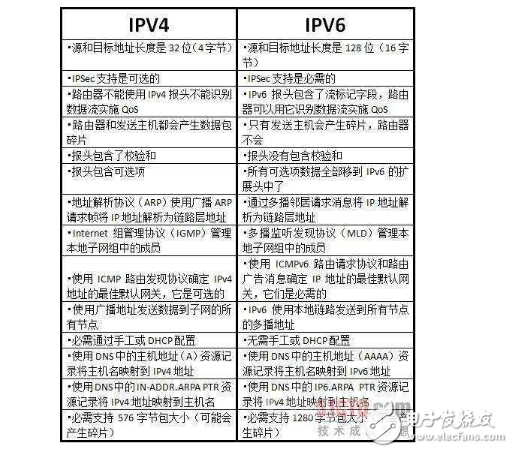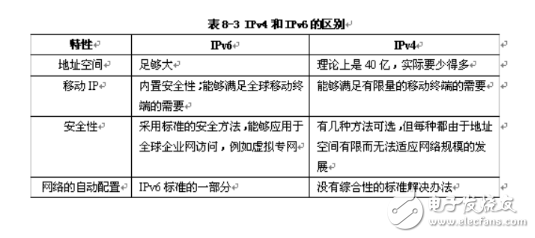Just as people communicate with each other, it is necessary to follow certain rules. The mutual communication between computers needs to abide by certain rules. These rules are called network protocols. The protocol family used in the current global Internet is the TCP/IP protocol suite. IP is the protocol of the network layer in the TCP/IP protocol suite and is the core protocol of the TCP/IP protocol suite.
In windows 7 and above, when setting the local IP address, I often see colleagues containing IPV4 protocol items and IPV6 protocol items, and different from the previous windows xp system only TCP/IP protocol items, many friends feel that comparing Strange, asking to edit the difference between IPv4 and IPv6, the following editor is for everyone to introduce the difference between IPv4 and IPv6.
The protocol family used in the current global Internet is the TCP/IP protocol suite. IP is the protocol of the network layer in the TCP/IP protocol suite and is the core protocol of the TCP/IP protocol suite. Currently, the version number of the IP protocol is 4 (abbreviated as IPv4), and it has been used for more than 30 years. The number of IPv4 address bits is 32 bits, that is, the computer with up to 2 32 powers can be connected to the Internet. In the past decade, due to the booming Internet, the demand for IP addresses has become larger and larger, making IP addresses The distribution is becoming more stringent, and the data show that the global IPv4 address may be completed between 2005 and 2008.
IPv4 protocol:The protocol family used in the current global Internet is the TCP/IP protocol suite. IP is the protocol of the network layer in the TCP/IP protocol suite and is the core protocol of the TCP/IP protocol suite. Currently, the version number of the IP protocol is 4 (abbreviated as IPv4), and it has been used for more than 30 years.
The number of IPv4 address bits is 32 bits, that is, a computer with up to 2 32 powers can be connected to the Internet. In the past ten years, due to the booming Internet, the demand for IP addresses has become more and more serious, making the distribution of IP addresses more stringent. Various data show that the global IPv4 address may be completed in 2005-2008.
IPv6 protocol:IPv6 is the next version of the Internet Protocol. It can also be said to be the protocol of the next generation Internet. It was originally proposed because with the rapid development of the Internet, the limited address space defined by IPv4 will be exhausted, and the shortage of address space will hinder Further development of the Internet. In order to expand the address space, it is proposed to redefine the address space through IPv6. IPv6 uses a 128-bit address length to provide an address with almost unlimited. The IPv6 actually assignable address is estimated in a conservative way, and more than 1000 addresses can be allocated per square meter of the entire earth. In the design process of IPv6, in addition to solving the address shortage problem once and for all, it also considers other problems that are not well solved in IPv4, mainly end-to-end IP connection, quality of service (QoS), security, multicast, mobile Sex, plug and play, etc.

The IPV6 and IPV4 protocols have long been known. IPv4, the fourth edition of the Internet Protocol (IP), is the first protocol that is widely used to form the cornerstone of today's Internet technologies. Its next version is IPv6. IPv6 is in the process of continuous development and improvement, and it will replace the widely used IPv4 in the near future.
In IPv4, the IP address length is 32 (divided according to the TCP/IP reference model), that is, there are 2^32-1 addresses. IPv6 was originally proposed because with the rapid development of the Internet, the limited address space defined by IPv4 will be exhausted, and the lack of address space will hinder the further development of the Internet. In order to expand the address space, it is proposed to redefine the address space through IPv6. IPv6 uses a 128-bit address length to provide an address with almost unlimited.
The IPv6 actually assignable address is estimated in a conservative way, and more than 1000 addresses can be allocated per square meter of the entire earth. In the design process of IPv6, in addition to solving the address shortage problem once and for all, it also considers other problems that are not well solved in IPv4, mainly end-to-end IP connection, quality of service (QoS), security, multicast, mobile Sex, plug and play, etc.

Larger address space. In IPv4, the IP address length is 32, that is, there are 2^32-1 addresses; and the length of the IP address in IPv6 is 128, that is, there are 2^128-1 addresses.
Smaller routing table. IPv6 address allocation begins with the principle of clustering (AggregaTIon), which enables the router to use a record (Entry) to represent a subnet in the routing table, which greatly reduces the length of the routing table in the router and improves router forwarding. The speed of the packet.
Enhanced multicast (MulTIcast) support and streaming support (Flow-control). This has enabled the development of multimedia applications on the network to provide a good network platform for quality of service (QoS) control.
Added support for Auto-configuraTIon. This is an improvement and extension of the DHCP protocol, making the management of the network (especially the local area network) more convenient and faster.
Higher security. In an IPv6 network, users can encrypt data at the network layer and verify IP packets, which greatly enhances network security.
Unfortunately, the new standard is not backward compatible. As an alternative, IPv4 and IPv6 must coexist. In the future, most Internet content and application services will continue to arrive through IPv4, and the use of IPv6 will also open up a vast new world.
In fact, both home and business users must now take action. The need to acquire more Internet addresses or advanced network services can only be achieved through the new IPv6 standard during the lifecycle of any network device purchased today. Although IPv4 addresses are still available, there are clear business cases that negate this situation, as past technology insufficiency and falling investment will result in increased risk costs. Therefore, each network device purchased must support both IPv6 and IPv4.
Obviously, IPv4 is already a drag on efficient networks, so plan from now on and move all solutions to support IPv6.
It is worth noting that IPv6 is a breakthrough technology. Some operators have completely introduced IPv6 to their own networks, ignoring the need to run IPv4 and IPv6 dual-stack users, thus increasing the risk of customer access diagnosis and configuration problems. . Technicians will choose to deploy dual stacks on the customer edge network as edge devices, whether routers or Layer 3 switches, that will handle IPv4 and IPv6 traffic separately in the home or office. So the choice of forward-thinking network providers is to innovate the dual-stack environment to ensure a smooth transition, facilitate better forwarding of network data, and lower total cost of ownership.
Through the above reading, I believe that everyone has a deeper understanding of the difference between IPv4 and IPv6. In fact, the only TCP/IP protocol item in Windows XP system is the IPV4 protocol in Windows 7, but it is clearer in Windows 7 system. The distinction is only.
Shaded Pole Motor,Capacitor Motor Yc Series,Capacitor Motor Tl61,Shaded Pole Ac Motor
Wentelon Micro-Motor Co.,Ltd. , https://www.wentelon.com